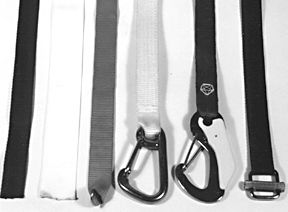]It began with a question from a Chicago reader, Carl Beyer, who said he’s currently cruising in the West Indies: “On anything more than a quick passage of a few hours aboard our 35′ ketch, we like to get the hard dinghy aboard and not worry about it riding along behind us. This is particularly so when the weather is brisk or better. I say, ‘better’ (rather than ‘worse’) because with a ketch you can stand a good bit more wind than can those ‘sloopies.’

“Our problem is lashing down the dinghy. It’s not easy to tie it tightly. We’ve tried both three-strand nylon and Dacron braided line, but no matter how well we snub the hitches, they always seem to loosen up and provide some undesirable slack. We don’t trust shock cord. Can you think of an option?”
Practical Sailor’s search for options turned up, repeatedly and most often, a solution called Webbing.
Webbing is greatly favored for life harness tethers, sail ties, dodger straps, to lash battcars to sail cringles and to “spider web” the heavy loads at the clews and tacks of sails.
Still, webbing is sometimes called the most overlooked material available to sailors—by those who make and sell it, of course.
Who makes it? There are literally hundreds of web mills turning out everything from 12″ slings to pick up construction equipment being helicoptered to the top of skyscrapers to puny little straps on kids’ backpacks. Most manufacturers, fled from New England, are in the South. One of the biggest is Tapecraft in Anniston, Alabama. It’s owned by YKK, the big Japanese zipper company.
The biggest supplier to the marine industry is Bainbridge International in Canton, Massachusetts. While most of its business is sailcloth and sail fittings, its webbing and web hardware business is an important adjunct.
Speaking for Bainbridge, Richard Morell and Scott Sartrys explained that tubular webbing, manufactured in the same way as the cover on double-braid rope, is stronger than flat webbing. The best tubular webbing is called, in the trade, maxi webbing and the 1″ size can have a breaking strength of 11,000 pounds. It can be identified by a black tracer along each edge and down the middle.
“If you’re buying webbing for use on a boat,” says Sartrys, “… or anything else, be advised that there are many grades, and you must match usage to quality. Basically, the heavier it is, the better.”
Along with proper webbing, you need proper hardware. A fair portion of the marine hardware business is devoted to making metal and plastic fittings for webbing.
Basic to attaching webbing to a deck or bulkhead are what are called footman’s loops, a.k.a. bridges. They are important to provide the webbing with a good even bight, which prevents edge-loading (perhaps leading to tearing) of the webbing.
The ends can be fastened with shackles, D-rings, triangles, side-release buckles, sliding bar adjustors or aircraft-type buckles. Lengths can be changed with three-bar slides. There even are fittings that permit the use of a short piece of shock cord on the end of the webbing. It might be handy in low-load applications.
Some of the great variety of hardware is shown in the photo above, but remember—stainless steel hardware is almost always stronger than plastic.
Ronstan, Schaefer, Wichard, and Suncor make excellent web hardware. If you want to see an amazing variety of hardware available for webbing applications, check with an English company called Sea Sure for a catalog.
Jacklines
The most prominent use for webbing on cruising sailboats is in jacklines for safety on deck. They should run port and starboard from the bow cleats, or from shackles on the toerail forward, back to the cockpit, but should stop far enough from the transom that you don’t get swept overboard and dragged behind the boat.

John Rousmaniere, in his The Annapolis Book of Seamanship, says that webbing is best for jacklines, pointing out that it won’t be confused with other line on deck. Likewise, in the Offshore Sailing Encyclopedia, Steve Dashew writes, “Ideally, jacklines will be made from flat webbing (which doesn’t roll under your feet like line or wire).”
Both these points are correct, but there’s a bit more to consider: Plain nylon jacklines stretch considerably when soaked and worked hard, as most people who have spent a few days on a wet passage will confirm. Rousmaniere has pointed out that some of the injuries in the disastrous 1998 Sydney-Hobart Race were the result of people being thrown long distances after their jacklines and tethers had slackened.
Minimum-stretch systems made of wire or high-tech line like Spectra offer greater support to a crewmember leaning against them at the mast or on the foredeck, but these, too, have their bad points: Fetching up at the end of your tether on a bar-taut jackline can be just as injurious as being thrown loosely. Plus, the stresses and shock-loads when that happens are more likely to damage or break terminals and knots somewhere along the line in the system.
As is often the case aboard sailboats, the best solution is probably either a matter of seamanship habits or a well-considered compromise purchase: Either go with the nylon and make sure you have it cinched up tightly when it gets wet (or better yet, set it up when it’s wet and let it dry taut), or buy polyester (Dacron) webbing, which will stretch under load, but not as much as nylon.
Contacts- Bainbridge, 255 Revere, Canton, MA 02021, 800/422-5684, www.bainbridgeint.com. Ronstan, 7600 Bryan Dairy Rd., Largo, FL 33777, 727/545-1911, www.ronstan.com. Schaefer, 158 Duchaine, New Bedford, MA 02745, 508/995-9511, www.schaefermarine.com. Sea Sure, Shore Rd., Warsash, Hampshire SO31 9GQ England, 44 (0) 1489 885401, www.sea-sure.co.uk. Suncor, 7 Riverside Dr., Pembroke, MA 02359, 800/394-2222, www.suncorstainless.com. Wichard, 47 Highpoint, Portsmouth, RI 02871, 800/852-7084, www.wichard.com.






































